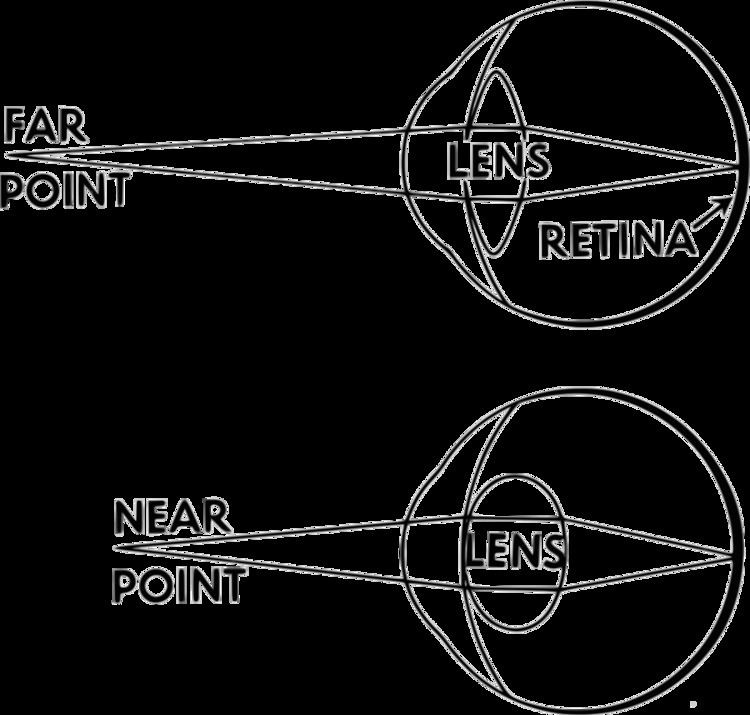 | ||
Accommodation (Acc) is the process by which the vertebrate eye changes optical power to maintain a clear image or focus on an object as its distance varies. In this, distances vary for individuals from the far point—the maximum distance from the eye for which a clear image of an object can be seen, to the near point—the minimum distance for a clear image.
Contents
Accommodation acts like a reflex, but can also be consciously controlled. Mammals, birds and reptiles vary the optical power by changing the form of the elastic lens using the ciliary body (in humans up to 15 dioptres). Fish and amphibians vary the power by changing the distance between a rigid lens and the retina with muscles.
The young human eye can change focus from distance (infinity) to as near as 6.5 cm from the eye. This dramatic change in focal power of the eye of approximately 15 dioptres (the reciprocal of focal length in metres) occurs as a consequence of a reduction in zonular tension induced by ciliary muscle contraction. This process can occur in as little as 350 milliseconds. The amplitude of accommodation declines with age. By the fifth decade of life the accommodative amplitude can decline so that the near point of the eye is more remote than the reading distance. When this occurs the patient is presbyopic. Once presbyopia occurs, those who are emmetropic (do not require optical correction for distance vision) will need an optical aid for near vision; those who are myopic (nearsighted and require an optical correction for distance vision), will find that they see better at near without their distance correction; and those who are hyperopic (farsighted) will find that they may need a correction for both distance and near vision. Note that these effects are most noticeable when the pupil is large; i.e. in dim light. The age-related decline in accommodation occurs almost universally to less than 2 dioptres by the time a person reaches 45 to 50 years, by which time most of the population will have noticed a decrease in their ability to focus on close objects and hence require glasses for reading or bifocal lenses. Accommodation decreases to about 1 dioptre at the age of 70 years. The dependency of accommodation amplitude on age is graphically summarized by Duane’s classical curves.
Theories of mechanism
Induced effects of accommodation
When humans accommodate to a near object, they also converge their eyes and, as a result, constrict their pupils. However, the constriction of the pupils is not part of the process called lens accommodation. The combination of these three movements (accommodation, convergence and miosis) is under the control of the Edinger-Westphal nucleus and is referred to as the near triad, or accommodation reflex. While it is well understood that proper convergence is necessary to prevent diplopia, the functional role of the pupillary constriction remains less clear. Arguably, it may increase the depth of field by reducing the aperture of the eye, and thus reduce the amount of accommodation needed to bring the image in focus on the retina.
There is a measurable ratio between how much convergence takes place because of accommodation (AC/A ratio, CA/C ratio). Abnormalities with this can lead to binocular vision problems.
Accommodative dysfunction
Duke-Elder classified a number of accommodative dysfunctions:
